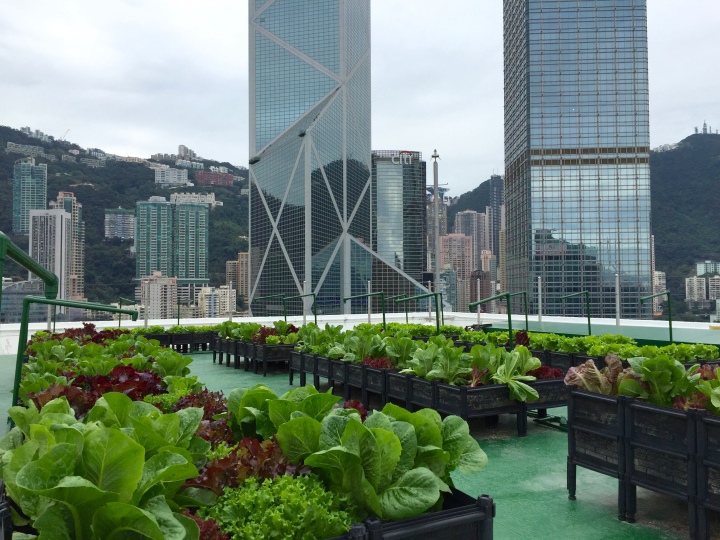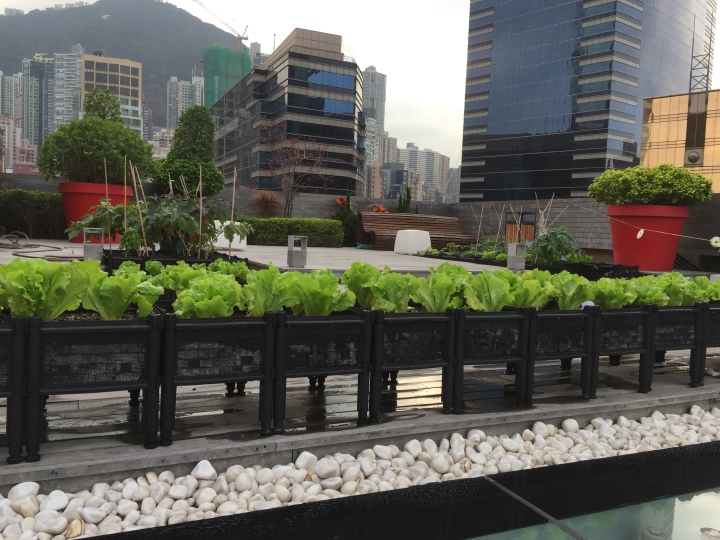
Urban farming on rooftops has been gaining traction in cities around the world. Its rise can originally be traced to consumers increasing awareness of carbon emissions that result when our food travels hundreds, if not thousands of miles from the farm to our table. As an experienced urban farmer that grows on the rooftops of commercial buildings such as the Bank of America Tower, and as a farming instructor at schools and universities such as HKU, I’ve gained an in depth understanding of the challenges, as well as the opportunities.
Space limitations in a city such as Hong Kong make rooftop farming an attractive option for growers. Farming on the rooftop creates numerous social, economic and environmental benefits. A HKU paper examining green roofs concluded that:
“Apart from enhancing the city landscape and environment, mitigating the urban heat island effect and improving air quality, green roof can improve the microlimate and increase the life span of waterproof and insulation facilities on the roof. Consequently, roof greening with a sufficient large scale is conducive to energy conservation and life cycle cost saving for the urban city.
Green roofs can help reduce three of the four top problems facing the society in the next 50 years: energy, water, and environment. In this way, the green roof technology has a potential to improve quality of population health and welfare in the urban areas with dramatically reduced vegetation.”
Rooftop farms reduce the carbon footprint of our food. Most of our fresh vegetables are transported hundreds of miles in refrigerated trucks. For consumers, rooftop farming provides fresher, more nutritious produce and reduces our reliance on imports which today account for 98% of all vegetables consumed in Hong Kong. Vegetables grown on rooftop farms can reach consumers in a day instead of weeks. According to this Harvard paper, “foods grown far away that spend significant time on the road, and therefore have more time to lose nutrients before reaching the marketplace.” Up to 40% of the nutritional value of fresh produce can be lost during transport and distribution.
Urban farming can also help to address the issue of our ever expanding landfills. Food waste constitutes 37% of total landfill waste. This food waste can instead be composted to produce a nutrient rich growing medium which is highly sought after by organic growers. In Hong Kong, most food waste is not used to make compost in part because there is no local demand for the end product. Urban farms create local demand for compost, thereby helping to reduce the amount of food waste entering our landfills.
Increasing demand for food waste compost has many positive effects. First, it recycles the nutrients contained in our waste to grow more fresh produce. Second, as a superior growing medium it reduces demand for fertilisers. Third, it reduces greenhouse gas emissions. Dumping food waste into an anaerobic environment, such as a landfill, produces methane, a greenhouse gas at least 16 times more powerful than CO2. Aerobic composting of food waste can reduce the climate change impact of our landfills.
Rooftop farming also creates the opportunities for employment, education and community engagement. For example, the Riverpark Cafe in NYC employs a full-time professional farmer to create a unique farm-to-table dining experience. In Detroit and Vancouver, urban farming projects have revitalised communities and created employment. At Wildroots Organic in Hong Kong, we have been integrating the science curriculum in hands on farming lessons that engage students.
While urban farming can help address many of our social and environmental issues, there remain many challenges that make widespread implementation difficult. In a future article, we will explore these challenges and share our lessons learned.



It’s great to see that more and more people are talking about urban gardening here in HK! I only have a small balcony, but have enjoyed growing my own herbs and a few veggies and lots of plants. I’m always looking for ideas on how to use my small space to it’s fullest potential.